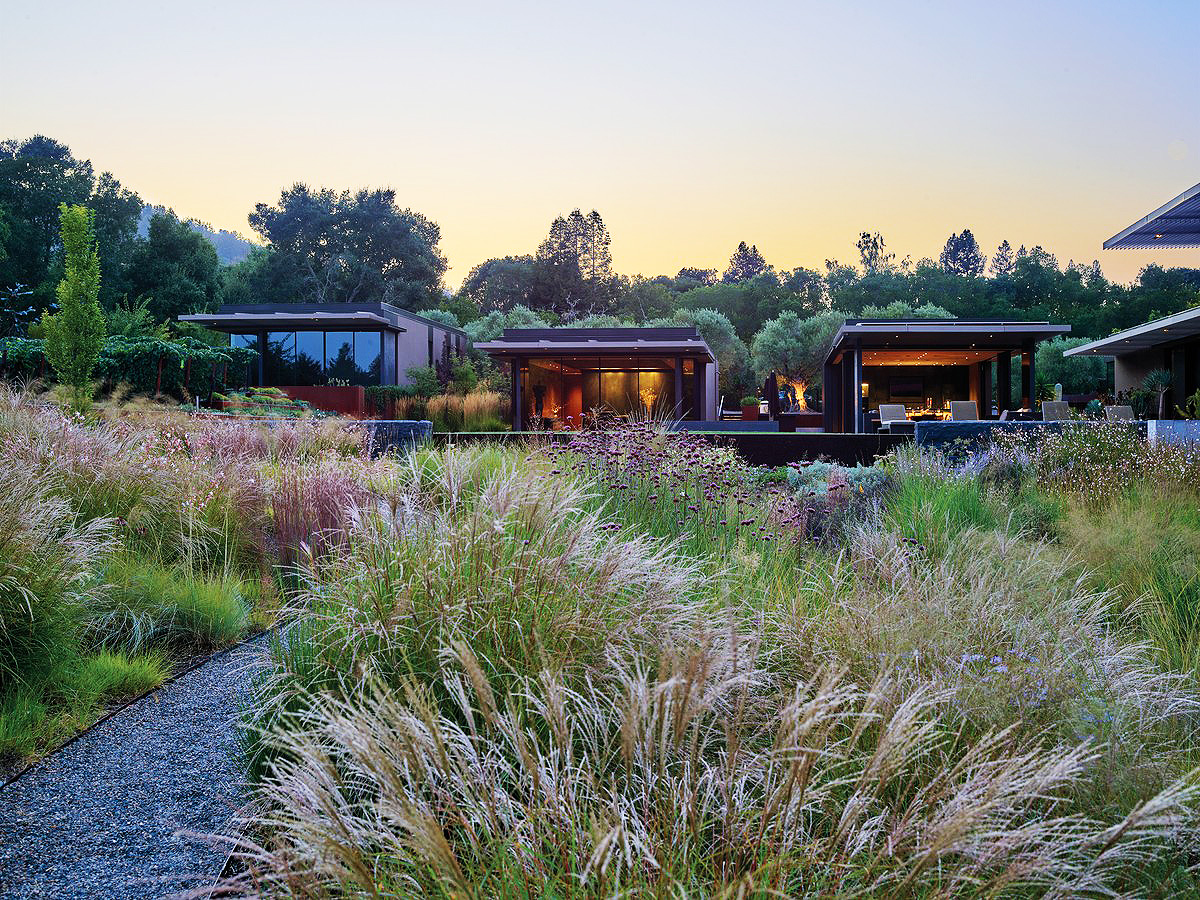
Photo © Marion Brenner
A naturalistic meadow at Uliveto, in California, dissolves the site into the borrowed scenery of the surrounding hills.
The lawn: verdant, lush, and neatly trimmed, a marker of status and belonging, and—as a seemingly essential complement to the modern home—a symbol of the American Dream. But it is also, increasingly, a burden: not just for owners to maintain, but for the environment to sustain. A monoculture covering some 50 million acres, the American lawn is the nation’s largest irrigated “crop.” It depletes aquifers, raises heat-island temperatures, impoverishes habitat, and damages ecosystems.
Regenerative landscapes, on the other hand, actively contribute to ecosystem health and human communities. They prioritize native plant species, improve soil structure, conserve water, and enhance biodiversity. Even so, some clients—and, in fact, some design professionals—object to the layered, seasonal messiness of an ecologically complex landscape, seeing it as incompatible with the clean lines and controlled form-making of contemporary residential design. “There is a common perception that a modern home should be paired with an equally modern landscape,” says Mike Albert, a principal in the Aspen, Colorado, studio of Design Workshop. “But there’s something beautiful about modern lines and forms within a more informal setting. A landscape rich in texture and diversity can heighten the architecture, and contribute to ecological repair.”
The three residential projects profiled here, completed over the last decade (landscapes take time to grow into their designers’ vision) and each a winner of a 2024 Honor Award from the American Society of Landscape Architects, make a strong case for the messy beauty of regenerative design. At Uliveto, in Woodlawn, California, Surfacedesign has integrated a house into its wider landscape with a meadow of native and adaptive plants in revitalized soil. At Montauk Bluffs, in Montauk, New York, LaGuardia Design Group (LDG) has stabilized a seaside bluff and extended the ambit of an adjacent nature preserve. At Cherry Creek Garden, in Denver, Design Workshop has re-established a sense of place while conserving water, fostering biodiversity, and advocating for broader change.
Literally underlying the potential of any landscape is its soil—whether sandy or clay, acidic or alkaline, well or poorly drained, eroded, contaminated, compacted, fertile, or a combination of conditions. “Just as much as a plant, soil is a living thing,” says James A. Lord, founding partner at San Francisco–based Surfacedesign. “Before we even start designing, we’re collaborating with soil scientists to understand the makeup of the soil, what has happened to it over time, and the ways we can work to regenerate a site.”
Exemplifying that process is the firm’s work at Uliveto, a 3.5-acre residential landscape completed in 2018 in the foothills of California’s Santa Cruz mountains. The design is organized into two roughly equal halves. One is a structured area that includes the Olson Kundig–designed house—a series of low volumes focused toward the view—along with a series of axial elements, such as reflecting pools and retaining walls, that extend the lines of the architecture into the landscape. This half also incorporates a pre-existing terraced vineyard and a 150-year-old olive orchard. The other half opens into a looser, more organic composition—a naturalistic meadow that dissolves the edges of the site into the borrowed scenery of the surrounding hills.

Photo © Marion Brenner
At Uliveto, a series of retaining walls and reflecting pools extend the lines of the architecture into the landscape.
The site of the meadow had for many years been used as a horse paddock. Trampling had compacted and pulverized the earth to the point where each step raised a little puff of dust; almost nothing would grow. To resuscitate the land, the design team began by sampling and analyzing soil from elsewhere on the property to identify key microbes of the native biome. These were then used to inoculate the soil of the former paddock through applications of compost tea (a liquefied version of solid compost). The team also took advantage of the house’s multiyear construction schedule to sow a cover crop of clover and various regional grasses, which loosened the soil, improved drainage, and added nutrients when they were plowed under.
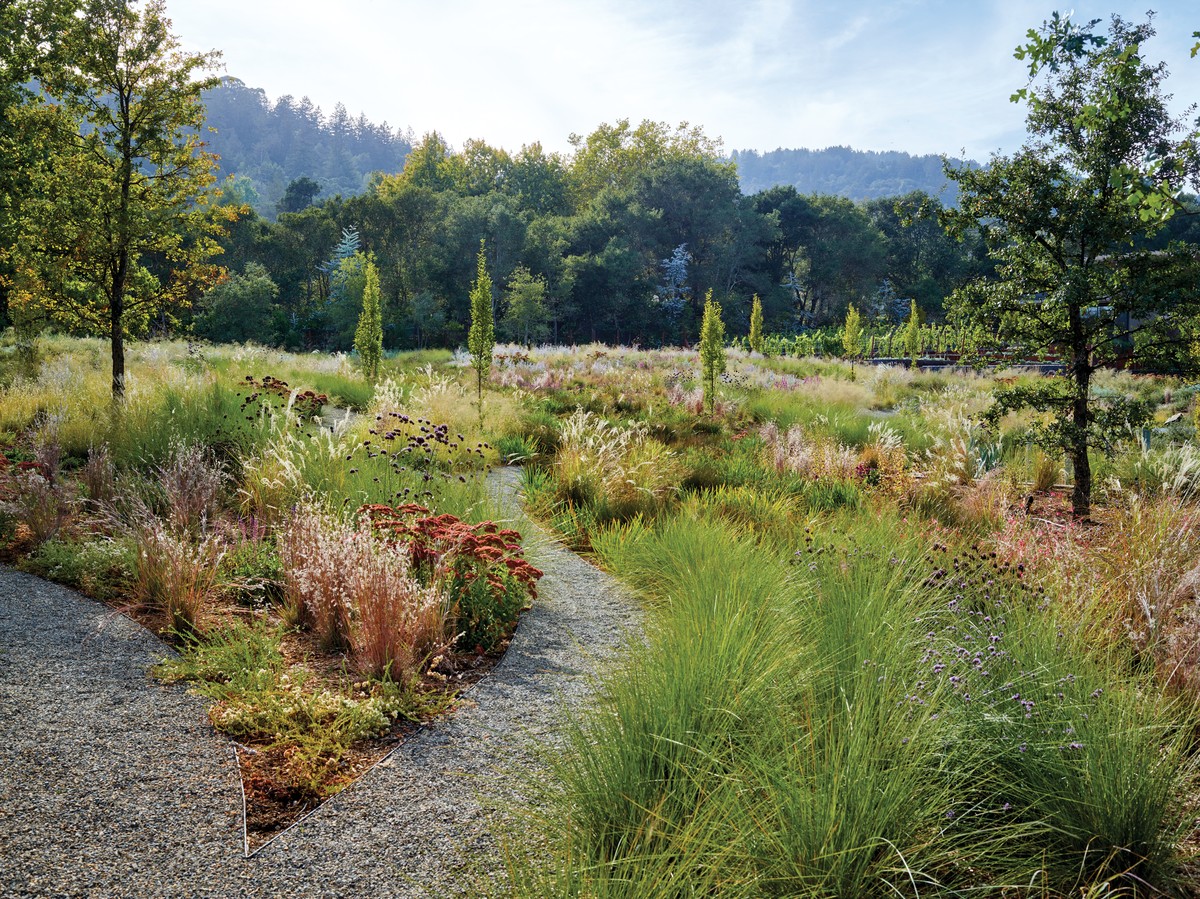
Photo © Marion Brenner
The highest points of the Uliveto landscape have plantings that require less water, including drought-tolerant grasses.
It isn’t always easy to convince clients to pay for something as unseen as soil. “On every project, we have to fight for it,” Lord says. But because soil microorganisms help plants to absorb nutrients and moisture and even to ward off disease, soil health translates directly to plant health. “It’s mind-blowing,” Lord says, “the growth we were able to get because we addressed the soil issues.”
Working within municipal restrictions on the amount of earth that a development can move, the landscape architect saved up the site’s allowance for the new meadow, shaping its topography to control the flow of rainwater across the site. Water conservation is a critical priority in California generally and for this site especially, and the resulting zones, from damp to dry, inform the meadow’s low-irrigation scheme.
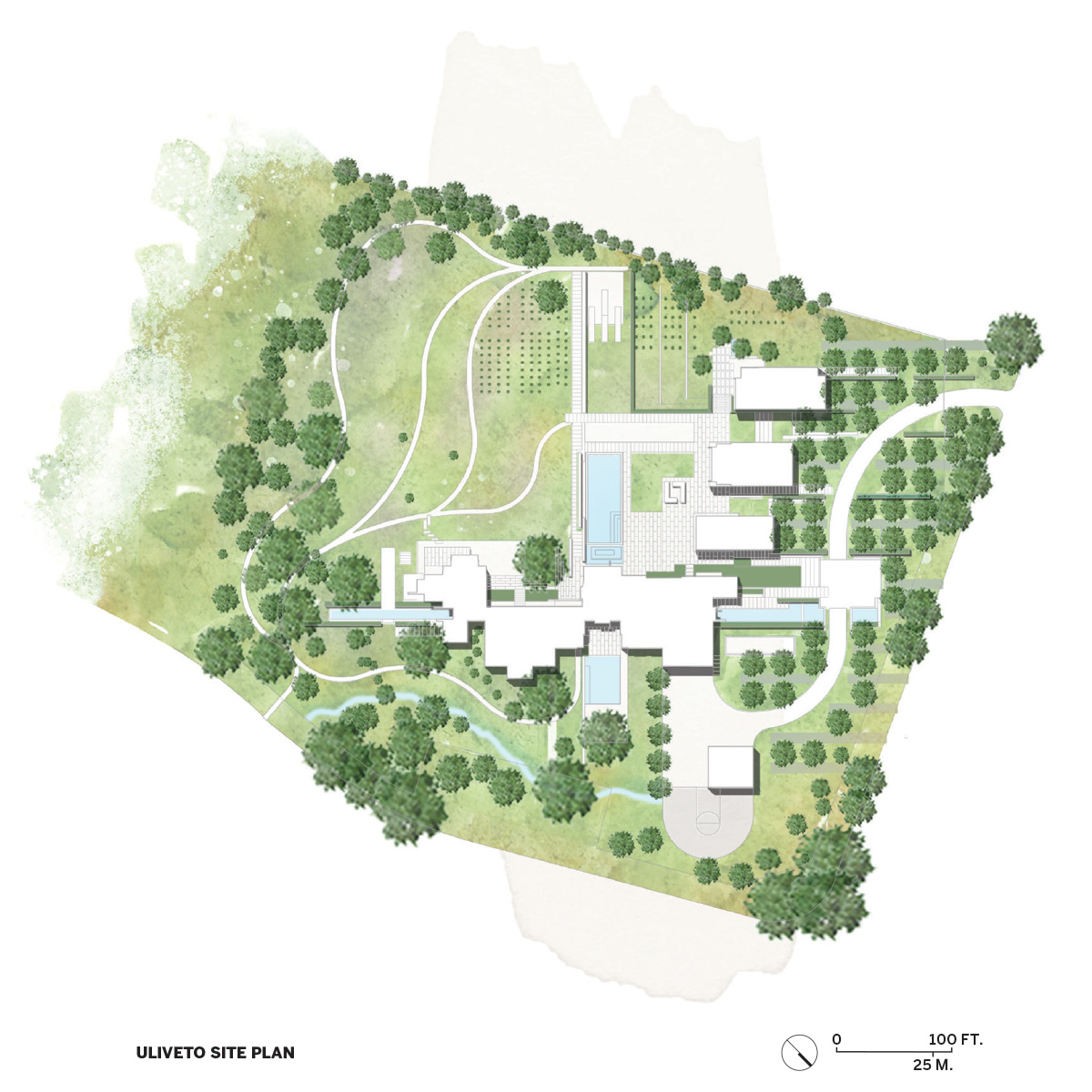
Courtesy Surfacedesign
The planting is arranged in drifts from the top of the gradient, where the most xeric (drought-tolerant) species grow, to the swales, where rainwater runoff supports a greener, more lush landscape. Evergreen subshrubs and blooming perennials form the core of the palette, with an infill of other low-water plants selected for their structure and habitat value.
The palette includes a wide variety of native plants and what Lord calls “cousin plants”—species that grow in the same band of latitude around the globe and are adapted to the same conditions as the site’s. “Our philosophy is that, unless you’re restoring a natural environment, you don’t have to limit the palette strictly to native plants. Sometimes adapted plants attract and host a wider variety of insects and birds,” Lord says. “Plant diversity is the important thing.”

Courtesy Surfacedesign
In developing a regenerative strategy for the Montauk Bluffs landscape (completed in 2016), Water Mill, New York–based LDG also focused on soil conservation, site-adapted plant selection, and water management—but under vastly different conditions. The weathered wood–clad house, originally built in the 1970s and renovated in 2015 by Robert Young Architects, sits atop a 70-foot rise facing the Atlantic, adjacent to a nature preserve. The bluffs are fragile. Heavy clay soil and salt-laden winds severely limit the viable planting palette; on top of that, highly invasive species had colonized the site—even encroaching on the nature preserve. And, among other new amenities on the narrow 1.15-acre lot, the program called for a swimming pool.
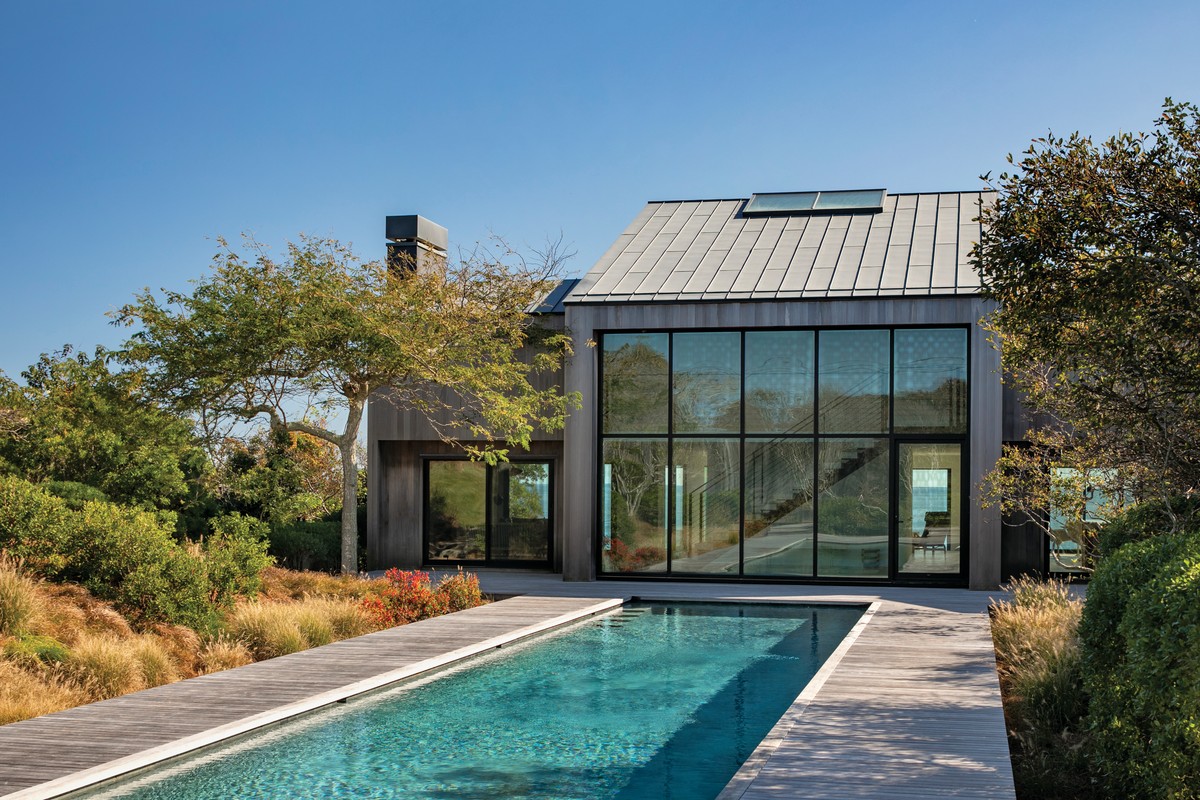
Photo © Anthony Crisafulli
A landward swimming pool at the Montauk Bluffs house acts as a prelude to an ocean view.
Programmatic decisions can have an outsize environmental impact, and convincing the client to locate the pool on the landward side of the house counts among the project’s main ecological achievements, says Chris LaGuardia, LDG’s founding principal. “That is counter to what every person who lives on the ocean wants to do,” he says. “But the bluff side was definitely not the right location, based on its sensitivity.” Beyond sparing the bluff, locating the pool landward enriched the experience of the site as a whole, providing a reason to spend time in the quieter setting, acting in place of a reflecting pool in the entry sequence, and introducing a water note as a prelude to the ocean view to come.
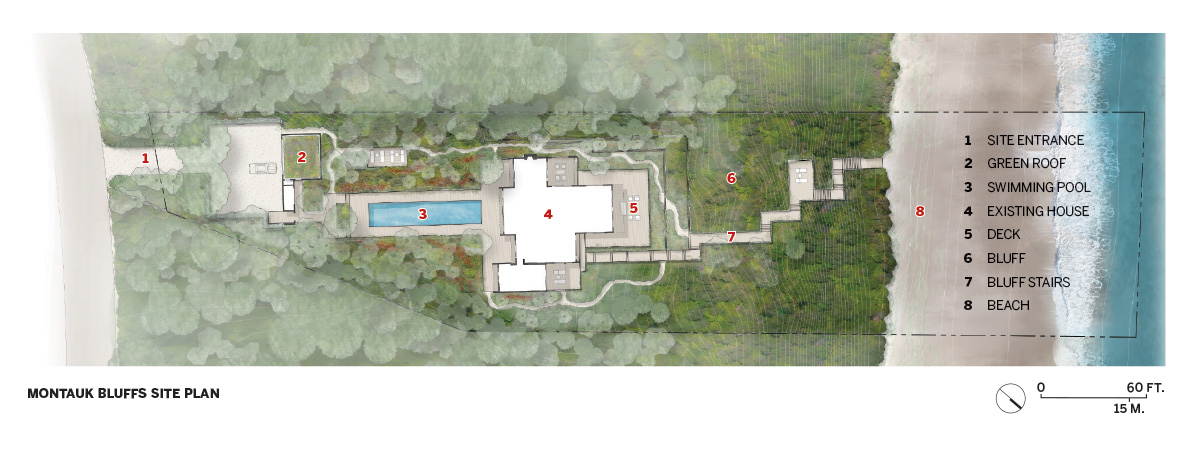
Courtesy LaGuardia Design Group

Photo © Marion Brenner
A naturalistic meadow at Uliveto, in California, dissolves the site into the borrowed scenery of the surrounding hills.
The lawn: verdant, lush, and neatly trimmed, a marker of status and belonging, and—as a seemingly essential complement to the modern home—a symbol of the American Dream. But it is also, increasingly, a burden: not just for owners to maintain, but for the environment to sustain. A monoculture covering some 50 million acres, the American lawn is the nation’s largest irrigated “crop.” It depletes aquifers, raises heat-island temperatures, impoverishes habitat, and damages ecosystems.
Regenerative landscapes, on the other hand, actively contribute to ecosystem health and human communities. They prioritize native plant species, improve soil structure, conserve water, and enhance biodiversity. Even so, some clients—and, in fact, some design professionals—object to the layered, seasonal messiness of an ecologically complex landscape, seeing it as incompatible with the clean lines and controlled form-making of contemporary residential design. “There is a common perception that a modern home should be paired with an equally modern landscape,” says Mike Albert, a principal in the Aspen, Colorado, studio of Design Workshop. “But there’s something beautiful about modern lines and forms within a more informal setting. A landscape rich in texture and diversity can heighten the architecture, and contribute to ecological repair.”
The three residential projects profiled here, completed over the last decade (landscapes take time to grow into their designers’ vision) and each a winner of a 2024 Honor Award from the American Society of Landscape Architects, make a strong case for the messy beauty of regenerative design. At Uliveto, in Woodlawn, California, Surfacedesign has integrated a house into its wider landscape with a meadow of native and adaptive plants in revitalized soil. At Montauk Bluffs, in Montauk, New York, LaGuardia Design Group (LDG) has stabilized a seaside bluff and extended the ambit of an adjacent nature preserve. At Cherry Creek Garden, in Denver, Design Workshop has re-established a sense of place while conserving water, fostering biodiversity, and advocating for broader change.
Literally underlying the potential of any landscape is its soil—whether sandy or clay, acidic or alkaline, well or poorly drained, eroded, contaminated, compacted, fertile, or a combination of conditions. “Just as much as a plant, soil is a living thing,” says James A. Lord, founding partner at San Francisco–based Surfacedesign. “Before we even start designing, we’re collaborating with soil scientists to understand the makeup of the soil, what has happened to it over time, and the ways we can work to regenerate a site.”
Exemplifying that process is the firm’s work at Uliveto, a 3.5-acre residential landscape completed in 2018 in the foothills of California’s Santa Cruz mountains. The design is organized into two roughly equal halves. One is a structured area that includes the Olson Kundig–designed house—a series of low volumes focused toward the view—along with a series of axial elements, such as reflecting pools and retaining walls, that extend the lines of the architecture into the landscape. This half also incorporates a pre-existing terraced vineyard and a 150-year-old olive orchard. The other half opens into a looser, more organic composition—a naturalistic meadow that dissolves the edges of the site into the borrowed scenery of the surrounding hills.

Photo © Marion Brenner
At Uliveto, a series of retaining walls and reflecting pools extend the lines of the architecture into the landscape.
The site of the meadow had for many years been used as a horse paddock. Trampling had compacted and pulverized the earth to the point where each step raised a little puff of dust; almost nothing would grow. To resuscitate the land, the design team began by sampling and analyzing soil from elsewhere on the property to identify key microbes of the native biome. These were then used to inoculate the soil of the former paddock through applications of compost tea (a liquefied version of solid compost). The team also took advantage of the house’s multiyear construction schedule to sow a cover crop of clover and various regional grasses, which loosened the soil, improved drainage, and added nutrients when they were plowed under.

Photo © Marion Brenner
The highest points of the Uliveto landscape have plantings that require less water, including drought-tolerant grasses.
It isn’t always easy to convince clients to pay for something as unseen as soil. “On every project, we have to fight for it,” Lord says. But because soil microorganisms help plants to absorb nutrients and moisture and even to ward off disease, soil health translates directly to plant health. “It’s mind-blowing,” Lord says, “the growth we were able to get because we addressed the soil issues.”
Working within municipal restrictions on the amount of earth that a development can move, the landscape architect saved up the site’s allowance for the new meadow, shaping its topography to control the flow of rainwater across the site. Water conservation is a critical priority in California generally and for this site especially, and the resulting zones, from damp to dry, inform the meadow’s low-irrigation scheme.

Courtesy Surfacedesign
The planting is arranged in drifts from the top of the gradient, where the most xeric (drought-tolerant) species grow, to the swales, where rainwater runoff supports a greener, more lush landscape. Evergreen subshrubs and blooming perennials form the core of the palette, with an infill of other low-water plants selected for their structure and habitat value.
The palette includes a wide variety of native plants and what Lord calls “cousin plants”—species that grow in the same band of latitude around the globe and are adapted to the same conditions as the site’s. “Our philosophy is that, unless you’re restoring a natural environment, you don’t have to limit the palette strictly to native plants. Sometimes adapted plants attract and host a wider variety of insects and birds,” Lord says. “Plant diversity is the important thing.”

Courtesy Surfacedesign
In developing a regenerative strategy for the Montauk Bluffs landscape (completed in 2016), Water Mill, New York–based LDG also focused on soil conservation, site-adapted plant selection, and water management—but under vastly different conditions. The weathered wood–clad house, originally built in the 1970s and renovated in 2015 by Robert Young Architects, sits atop a 70-foot rise facing the Atlantic, adjacent to a nature preserve. The bluffs are fragile. Heavy clay soil and salt-laden winds severely limit the viable planting palette; on top of that, highly invasive species had colonized the site—even encroaching on the nature preserve. And, among other new amenities on the narrow 1.15-acre lot, the program called for a swimming pool.

Photo © Anthony Crisafulli
A landward swimming pool at the Montauk Bluffs house acts as a prelude to an ocean view.
Programmatic decisions can have an outsize environmental impact, and convincing the client to locate the pool on the landward side of the house counts among the project’s main ecological achievements, says Chris LaGuardia, LDG’s founding principal. “That is counter to what every person who lives on the ocean wants to do,” he says. “But the bluff side was definitely not the right location, based on its sensitivity.” Beyond sparing the bluff, locating the pool landward enriched the experience of the site as a whole, providing a reason to spend time in the quieter setting, acting in place of a reflecting pool in the entry sequence, and introducing a water note as a prelude to the ocean view to come.

Courtesy LaGuardia Design Group
The design’s next big move was to eliminate the lawn. “We really wanted to honor the beauty of the surrounding landscape,” says Alex Bluedorn, a partner at LDG. “The idea of not having any lawn was intentional, from an ecological standpoint, and it also allowed that craggy Montauk vegetation to come right up to the house, so that it felt nestled in.”
Respecting the adjacent nature preserve, the new planting scheme consists entirely of native species. Many of them, including the winterberry shrubs and shad trees, are field collected rather than nursery grown. Windswept and irregular, they have more character and are typically more mature (so, bigger) than nursery stock. “You have to do it responsibly, though,” LaGuardia says. “We are constantly trawling the area for sites that are about to be cleared.”
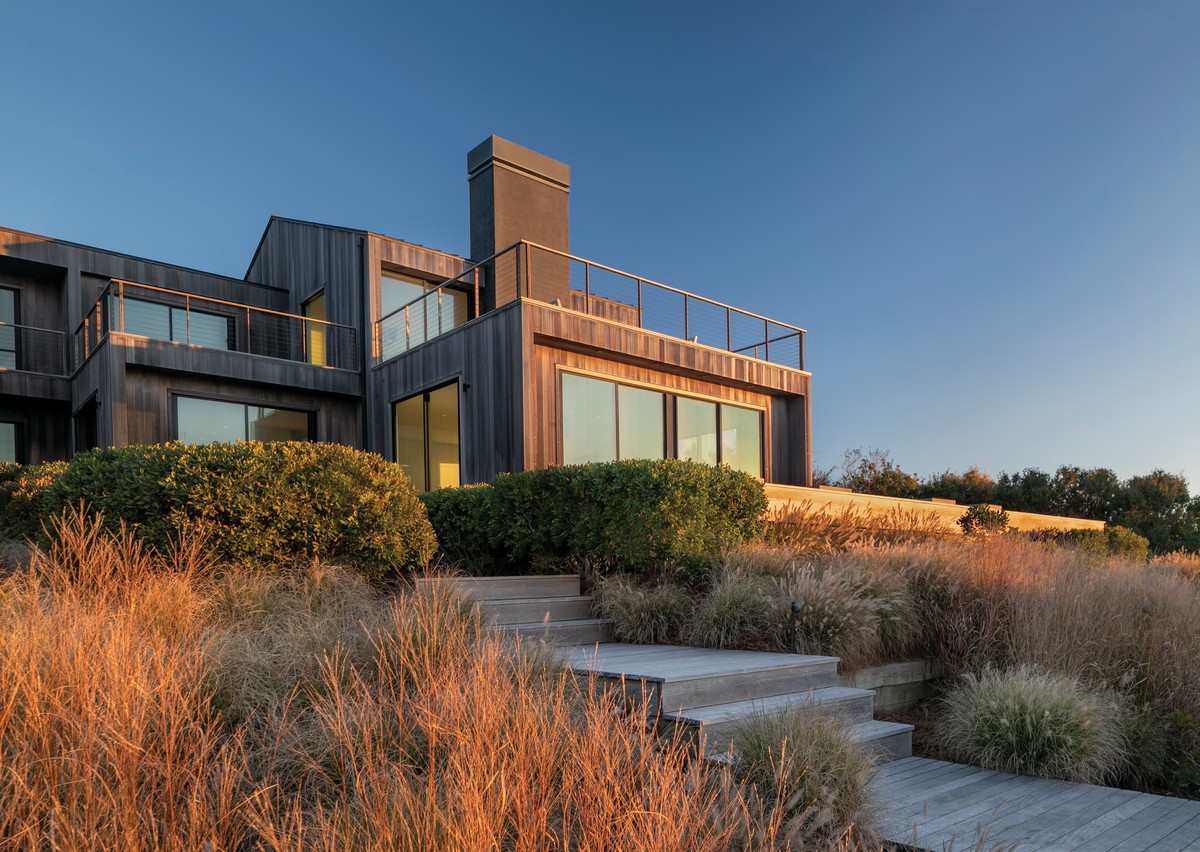
Photo © Anthony Crisafulli
A landward swimming pool at the Montauk Bluffs house (above) acts as a prelude to an ocean view. The planting scheme consists entirely of native species, including switch grass (above) and winterberry (below).

Photo © Anthony Crisafulli
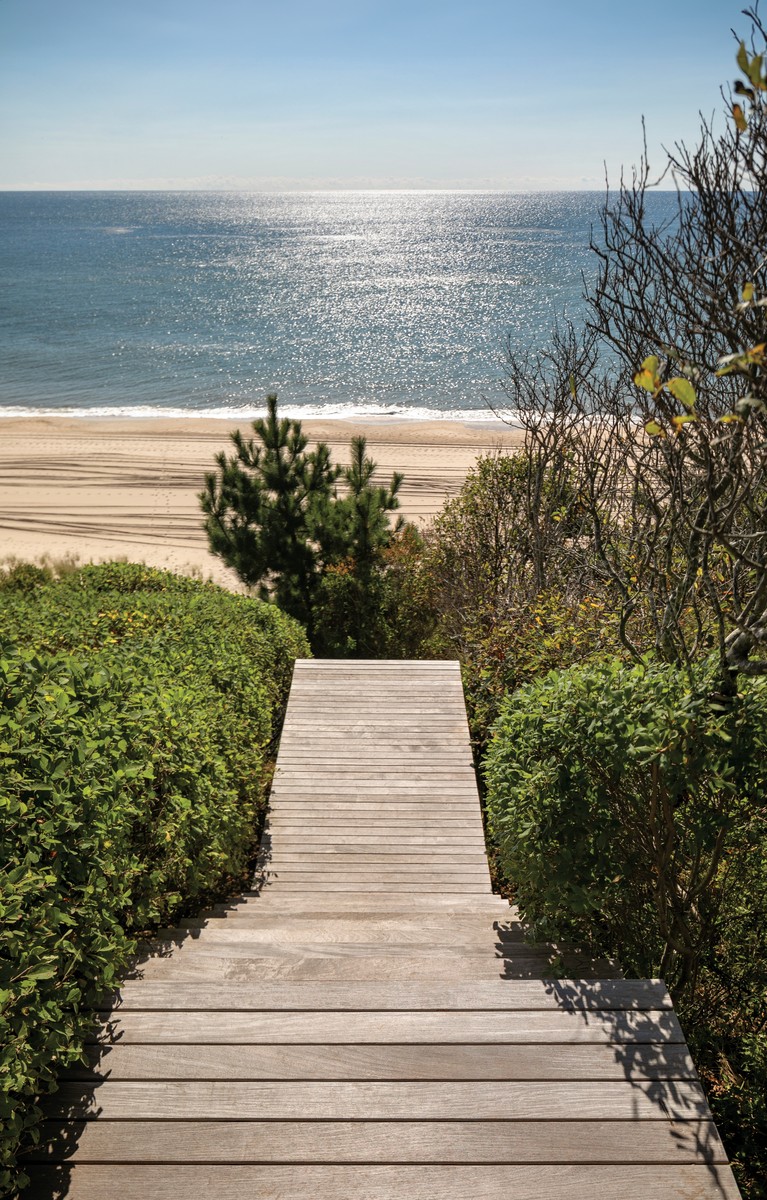
Photo © Anthony Crisafulli
Boardwalks and stairs that hover above the landscape limit the impact on the sensitive Montauk Bluffs site.
The new plants were installed at the same time that the invasive species were removed, so as not to leave the erosion-prone earth exposed. This was especially important on the fragile bluff, where greenery formed part of the stabilization strategy. On steeper sections, the newcomers themselves needed to be stabilized until they could get established, and for this the landscape architect specified a system of coir logs, a geotextile made out of coconut fiber and mesh, rolled up and staked down. The vegetation knits itself to the logs, which disintegrate over time; the stakes are then removed, and the plants hold the slope on their own.
To further mitigate erosion, runoff from hard surfaces is captured in dry wells—underground pits that retain and percolate excess water—so none of it runs down the face of the bluff. Primary circulation around the site consists of a system of elevated boardwalks, including a bluff-hugging zigzagging stair to the beach, with boards spaced to allow sunlight and rainfall to reach the native plants beneath. Secondary paths, for strolling or maintenance, are surfaced with locally sourced stone dust, a permeable material with a “beachy” feel similar to sand, but more stable.
The project’s combined strategies add up to what LaGuardia calls “a great example of how you can still get from your driveway to your front door, and use the property very comfortably, without needing a lawn, especially on an ecologically sensitive site.”
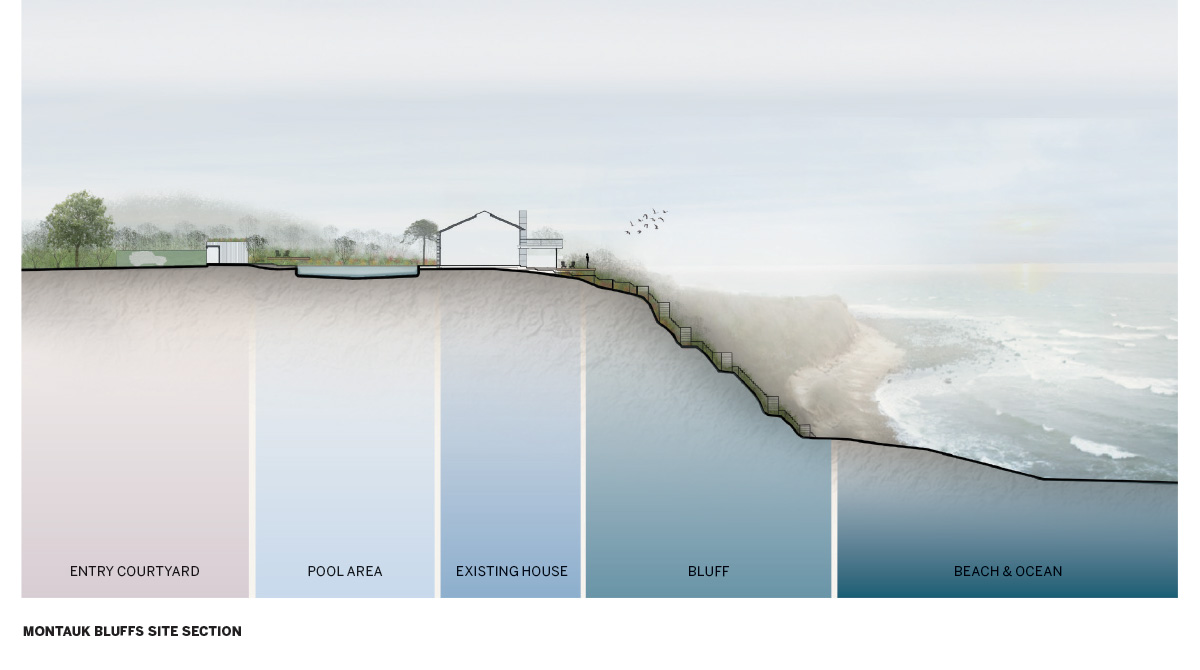
Courtesy LaGuardia Design Group
Where Uliveto and Montauk Bluffs make the case for regenerative landscapes in natural settings, Cherry Creek Garden takes the case to the city. The 3.5-acre parcel, located near a river that still serves as a wildlife corridor, sits in a historic suburb that was once on Denver’s edge and is now fully surrounded—central, in fact. The garden’s previous scheme included underused and under-maintained formal elements, such as a large and thirsty lawn, monocultural hedges in contorted shapes, and overgrown shrubbery. A 2022 renovation, in conjunction with alterations to the Prairie Style–influenced house (the original 2008 design and the alterations, both by Olson Kundig), offered a chance to reconceive the premise of the place. “These mature, large-lot neighborhoods have the opportunity to contribute a great deal of environmental significance to the city,” says Design Workshop’s Albert. “And when it’s not just one parcel, but expands out to the larger neighborhood and becomes 10 parcels, all of a sudden you can have 30 acres in the heart of a city.”
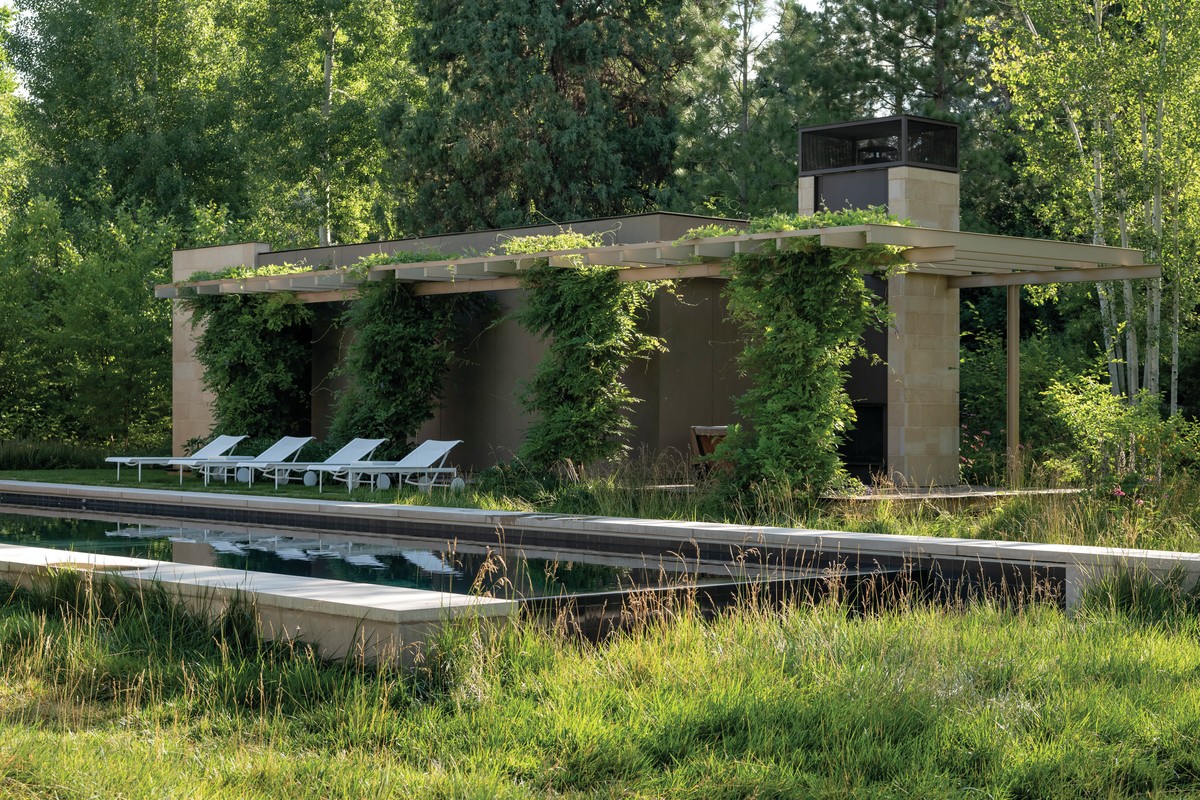
Photo © Brandon Huttenlocher / Design Workshop
At Cherry Creek Garden, in Denver, a new pavilion sits against a restored woodland edge.
Inspired by the ecological diversity of Colorado and the clients’ enjoyment of botanical gardens, the landscape architect created a series of horticultural vignettes: a grove of Ponderosa pines (a habitat species that naturalizes where the plains rise to the nearby foothills), a colorful xeric garden of Colorado wildflowers, a shade garden accented with regional boulders and specimen conifers, a dry creek that catches runoff from seasonal storms, and an existing meadow rehabilitated. “Our philosophy is to look around the site and the region,” Albert says, “and to listen to what they tell us about creating a garden that really celebrates its place.”
Within the series of vignettes, plant species were selected to support Denver’s Pollinator Trail, a citywide initiative that aims to restore native landscapes, combat climate change, improve biodiversity, and reduce the heat island effect. In beds bordering walkways, for example, a dozen or so species of flowering perennials, such as catmint, cranesbill, and yarrow, are arranged in a series of clusters, so that pollinators can hopscotch from one food source to the next.
While prioritizing conservation, biodiversity, and environmental fit, the garden equally fosters its owners’ use and enjoyment of the outdoors, juxtaposing natural and built elements to include reflecting and swimming pools, patios and terraces, and a firepit, with lights glowing in the trees like fireflies. “The project tries to find a balance between being responsive to the larger environment and also being a landscape that wants to be inhabited,” Albert says. “On the spectrum of wild to manicured, it is somewhere in the middle.”
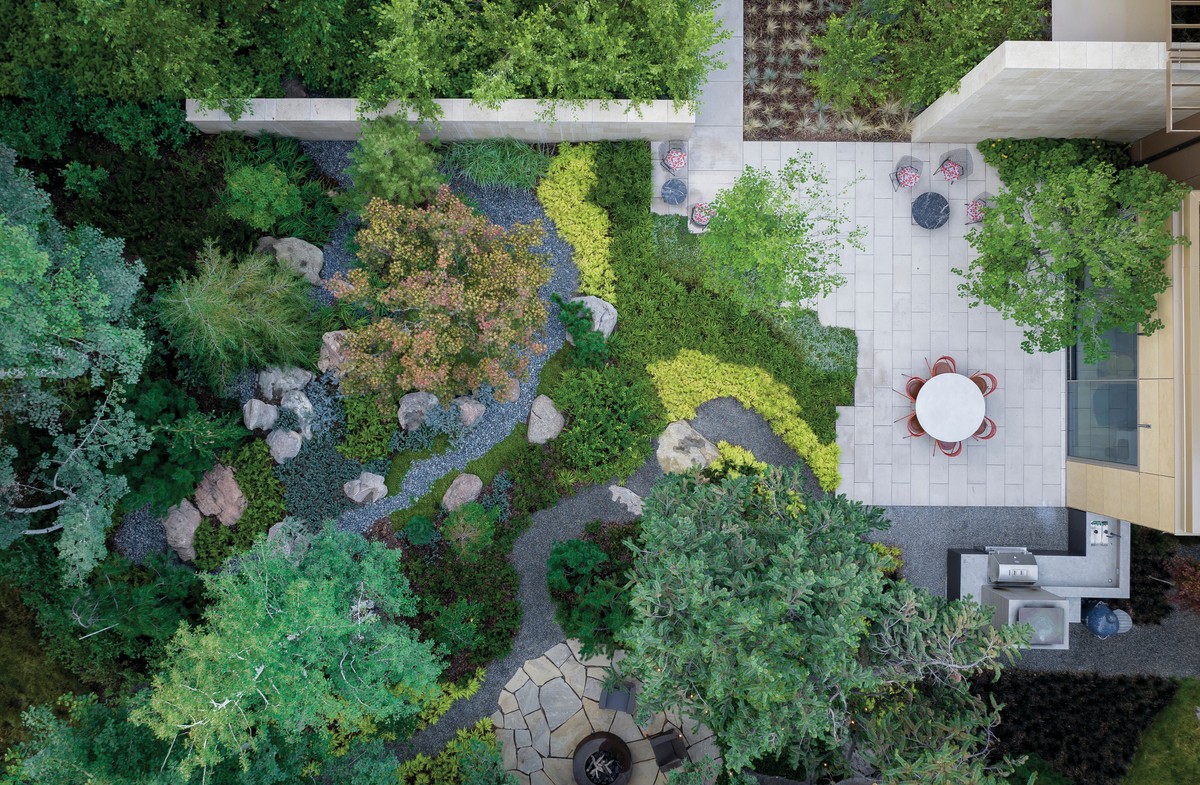
Photo © Brandon Huttenlocher / Design Workshop
Built elements at Cherry Creek Gardens, such as patios, terraces, and a firepit, foster the owners’ enjoyment of the outdoors.
As an indicator of how well the approach is being received in the neighborhood, Design Workshop has now been hired to renovate the garden next door. Extending Cherry Creek Garden’s influence even further, its owners make it available for community tours, conduct private tours, and host benefits; the project has also formed part of the Cultural Landscape Foundation’s Garden Dialogues program. “It’s all to try to change the perspective on what an urban garden can be,” Albert says.
While Cherry Creek Garden, Montauk Bluffs, and Uliveto exemplify key principles of site repair and conservation, the scale of individual projects and the importance to biodiversity of connected habitats limit the impact that any one garden—whether urban or rural—can achieve. Ultimately, these gardens’ most significant contribution to regenerative landscape design may well come from the advocacy of their example.
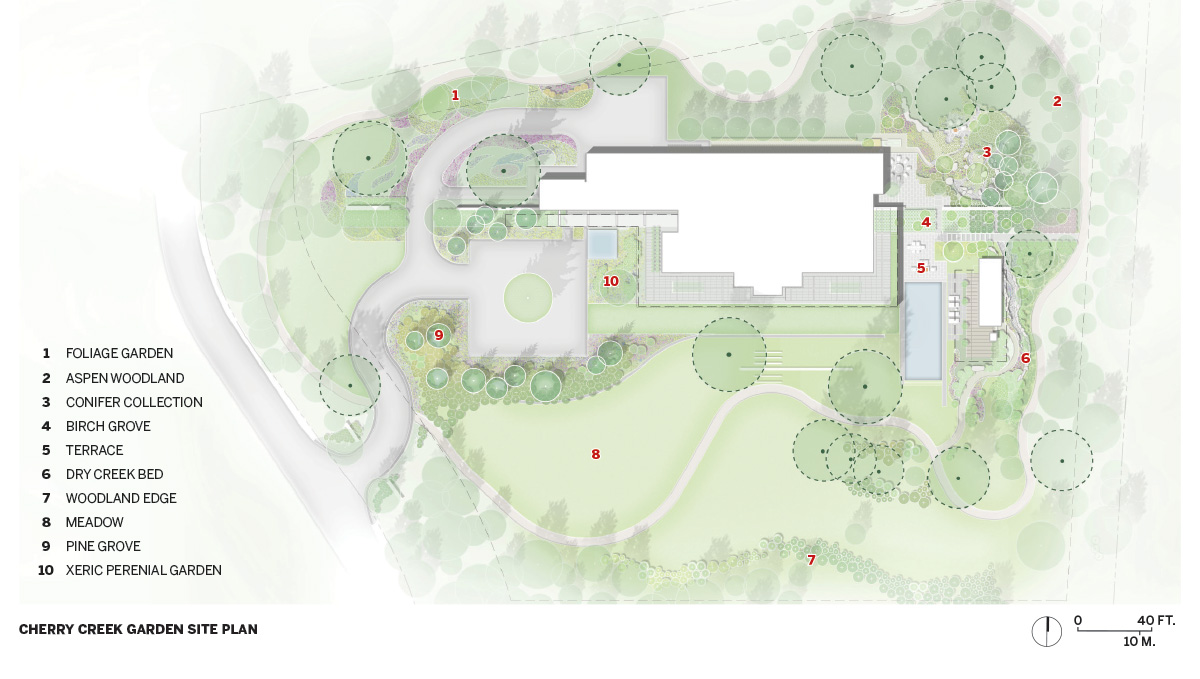
Courtesy Design Workshop
Suppemental Materials:
Regenerative Landscaping: How to Make Residential & Municipal Landscapes Part of the Climate Solution, Dr. Sara Via, Smithsonian Gardens, from time stamp 9:00 to 21:00.

























